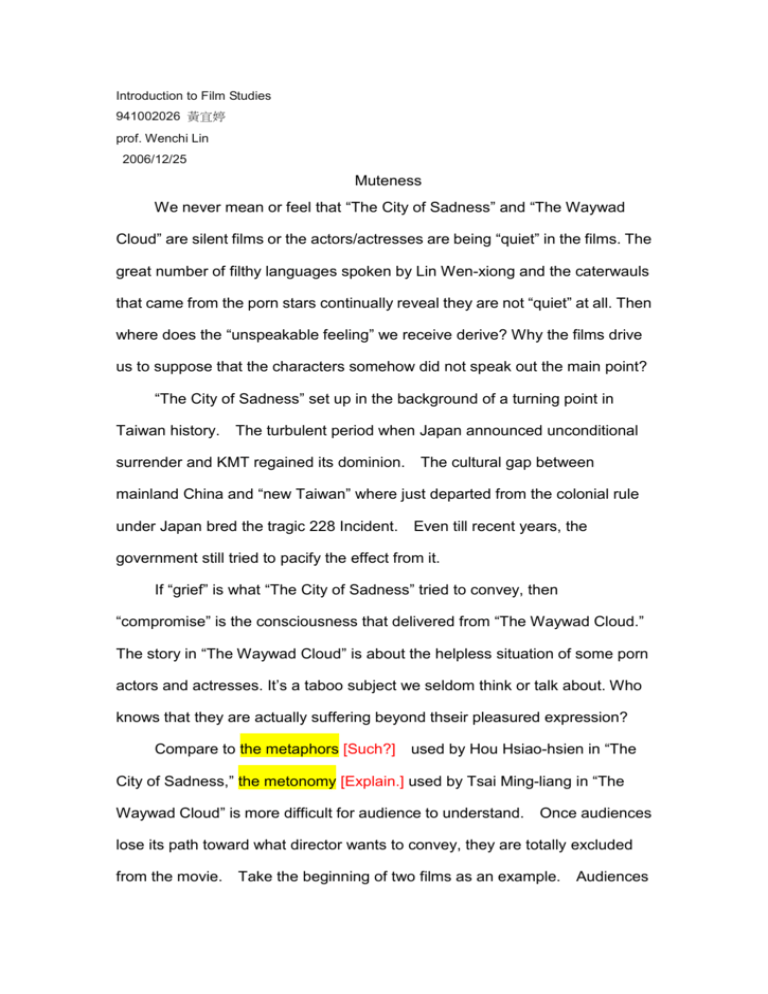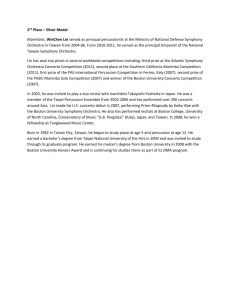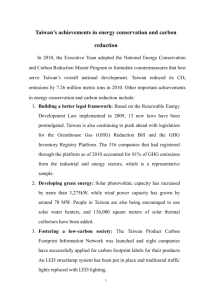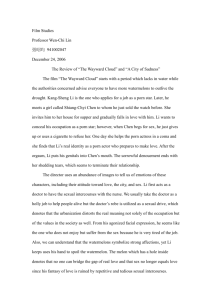Introduction to Film Studies
advertisement

Introduction to Film Studies 941002026 黃宜婷 prof. Wenchi Lin 2006/12/25 Muteness We never mean or feel that “The City of Sadness” and “The Waywad Cloud” are silent films or the actors/actresses are being “quiet” in the films. The great number of filthy languages spoken by Lin Wen-xiong and the caterwauls that came from the porn stars continually reveal they are not “quiet” at all. Then where does the “unspeakable feeling” we receive derive? Why the films drive us to suppose that the characters somehow did not speak out the main point? “The City of Sadness” set up in the background of a turning point in Taiwan history. The turbulent period when Japan announced unconditional surrender and KMT regained its dominion. The cultural gap between mainland China and “new Taiwan” where just departed from the colonial rule under Japan bred the tragic 228 Incident. Even till recent years, the government still tried to pacify the effect from it. If “grief” is what “The City of Sadness” tried to convey, then “compromise” is the consciousness that delivered from “The Waywad Cloud.” The story in “The Waywad Cloud” is about the helpless situation of some porn actors and actresses. It’s a taboo subject we seldom think or talk about. Who knows that they are actually suffering beyond thseir pleasured expression? Compare to the metaphors [Such?] used by Hou Hsiao-hsien in “The City of Sadness,” the metonomy [Explain.] used by Tsai Ming-liang in “The Waywad Cloud” is more difficult for audience to understand. Once audiences lose its path toward what director wants to convey, they are totally excluded from the movie. Take the beginning of two films as an example. Audiences were enveloped by the darkness of frame when “The City of Sadness” was played, and all we heard was background music of radio broadcasted in Japanese, with the groan from a woman. Later we knew the groan was due to a difficult delivery, and in this hard situation, there’s a power failure. Finally, the electric power recovered and the woman gave birth to a boy name Lin Guang-ming, which means “light.” With understanding of Taiwan history, it’s not hard for audience to interpret those signs. With the end of World War II, Japan announced unconditional surrender and gave up the colonial governance over Taiwan which remained fifty years long. For people in Taiwan, it should be pleasant news, they can return to their fatherland at last. Yet instead of gaining better living, the constantly conflict between new government and people was nonstop. The woman giving birth to a child at the beginning of the film somehow symbolized the renewing of Taiwan, yet it underwent the pain and delay. The long, long darkness of Japan’s colonial rule was finally over with metaphor of recovery of electric power. The boy named “light” came late, yet we still love him and hold hope toward him. On the other hand, what’s at the beginning of “The Waywad Cloud” is not so easy to understand. The long take of underground passage with two girls passing slowly with each other was not only obscure in meaning but also making audience impatient. If we don’t try hard to grasp the ideas in the movie or see it over and over again, shooting the walking process in the underground passage is meaningless. Once we get into the point, the metonomy used in film might be interesting term. [I think you have misused this “Metonomy” is using a part to represent the whole. What you describe here—the passway representing ovum duct is closer to a metaphor.] . The long underground passage could be seen as the space of oviduct, and two lonely ova meet each other, they lack for the combination of sperm, they yearn for the combination of sperm. satisfy them. Yet no one could ever or they never find one As the shortage of water in hot summer, without the supply of water, all you can do is try any method you can think of to get you water. reading is imaginative but a little bit farfetched. [The I don’t see what can be gained by interpreting the opening scene biologically.] And except the different expressing techniques that Hou Hsiao-hsien and Tsai Ming-liang use. Some ideas that both directors want to convey are very similar. Like what I have mentioned in the first paragraph, the “unspeakable feeling” that they both have. In “The City of Sadness,” Hou Hsiao-hsien created Lin family as a symbol of Taiwan people under the governance of KMT rather than assail KMT directly [Good]. The eldest son Lin Wen-xiong was a businessman yet his tavern closed down soon after the serial events in his family, finally he died in the conflict between gangs. And we never see the real person of the second son, only learn from Hiromi that he went to Southeast Asia for war. The third son ended up with being crazy, the fourth son Lin Wen-ching was deaf and incapable of speaking, in the end he’s still arrested by government. Four sons tell the different stories beneath KMT. Hou Hsiao-hsien doesn’t have to show us other families or blame KMT, we could know the great effect that happened to Taiwan people. Living in this period, you could be wrongfully accused of being a traitor, or being conflict with those who came to Taiwan with KMT. In “The Waywad Cloud,” Tsai Ming-liang took an unusual example of what Taiwan people [I don’t think the characters can represent all Taiwanese. You need to be more specific about what the film intends to express here.] might undergo, that is, in order to earn the living, they have to endure the physical suffering. And that suffering even influenced his ability to giving love. People couldn’t help but want to ask: Could it be said that only people in suit can make money? Could it be said that the money they earn is more honorable than those porn stars? Even these questions were raised, no one can answer it or solve the problems. As a result, Li Kang-sheng illusorily changed into reptile to sing “half-moon,” hoping to gain the other half of the moon. Besides expressing his yearning for the girl, he even more suggested his exist was meaningless [Good, but try to avoid the grammatical errors in your expression.]. As a porn actor, his main function was being a penis. Without him, the porn producer still can find another man replace his position and the world will go on revolving. He’s sad and yearning for love, yearning for someone who can prove that he’s not a reptile [Good]. Even if someone can speak out his or her misery and grief, what makes the difference? In “The City of Sadness,” “Fuck!” constantly came from Lin Wen-xiong’s mouth, giving his voice of discontent with his matters, discontent with this society. as Lin Wen-ching. Nothing changed at all, he’s just as incompetent of speaking That’s why we take these both films as symbol of muteness, with those who probably have the ability to speak, yet fail to speak. Your reading of the two films is quite unique. You point out interesting aspects of them. But in general you have not said enough about them. expect that you discuss many other symbolic scenes in both films. I I am not sure whether you could not see any other or you found them too obvious to mention. Grade: 80









